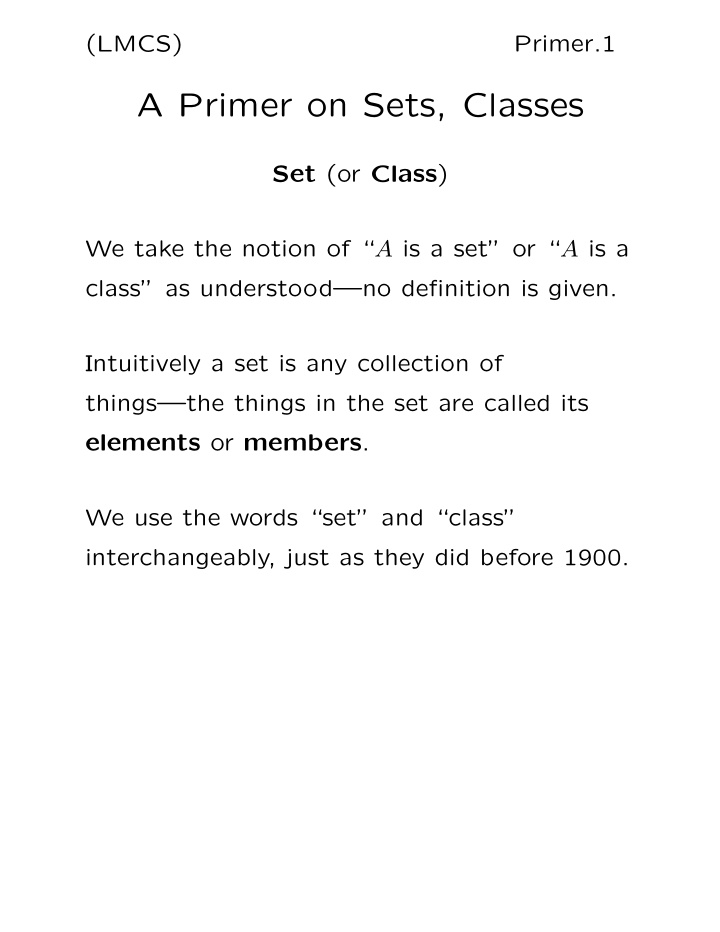



(LMCS) Primer.1 A Primer on Sets, Classes Set (or Class ) We take the notion of “ A is a set” or “ A is a class” as understood—no definition is given. Intuitively a set is any collection of things—the things in the set are called its elements or members . We use the words “set” and “class” interchangeably, just as they did before 1900.
(LMCS) Primer.2 According to Hilbert and Ackermann, 1928, philosophers prefer the word “class” and mathematicians prefer the word “set”. We like to draw sets as regions in the plane, and indicate elements by dots. Some A Set Elements
(LMCS) Primer.3 Set Membership We take the notion of set membership x ∈ A Read: x is an element of A as understood—no definition is given. A x The notation x / ∈ A means “ x is not an element of A ”. x A
(LMCS) Primer.4 Equality of Sets Two sets A and B are equal iff they have precisely the same elements, that is, iff every member of A is a member of B , and vice-versa. The Empty Set We define the set Ø Read: empty set to be a set with no elements in it. Exercise: Explain why there can be only one empty set.
(LMCS) Primer.5 Intension and Extension The notion of a rose has both intension and extension . Intension has to do with properties : x is a rose. Extension has to do with sets : The set of all roses. Properties are true or false for objects. Sets are just sets.
(LMCS) Primer.6 Using Properties to Make Sets We can ( naively ) express the construction of a set using a property with set-builder notation : { x : P ( x ) } Read: the set of elements for which P holds For example: roses = { x : x is a rose } .
(LMCS) Primer.7 In advanced set theory one has to be careful about the properties that one ascribes to sets. This is because of the famous Russell Paradox discovered in 1901 by Bertrand Russell. In such advanced work one likes to treat sets as special kinds of “not too big” classes. However such problems do not arise in our work.
(LMCS) Primer.8 Russell’s Paradox (1901) Let P ( x ) be the property x / ∈ x . Let A = { x : x / ∈ x } . Then iff P ( A ) iff ∈ A . A ∈ A A / But this is a contradiction. We have to be more careful about how we build sets!
(LMCS) Primer.9 Using Properties to Make Sets Given any property P ( x ) and set A there is a set whose elements are the elements x of A for which P ( x ) is true. The usual way of describing this set is by set-builder notation, namely { x ∈ A : P ( x ) } Read: the set of elements in A for which P holds For example: { x ∈ N : x is even. } .
(LMCS) Primer.10 Subset Given any two sets A and B we define A ⊆ B Read: A is a subset of B by: every element of A is an element of B . B A (An Euler Diagram ) A � B The notation means A is not a subset of B .
(LMCS) Primer.11 Union Given two sets A and B we define A ∪ B Read: A union B by x ∈ A ∪ B iff x ∈ A or x ∈ B . A B �✁�✁�✁�✁�✁�✁� ✂✁✂✁✂✁✂✁✂✁✂✁✂ ☎✁☎✁☎✁☎✁☎✁☎✁☎ ✄✁✄✁✄✁✄✁✄✁✄✁✄ �✁�✁�✁�✁�✁�✁� ✂✁✂✁✂✁✂✁✂✁✂✁✂ ☎✁☎✁☎✁☎✁☎✁☎✁☎ ✄✁✄✁✄✁✄✁✄✁✄✁✄ �✁�✁�✁�✁�✁�✁� ✂✁✂✁✂✁✂✁✂✁✂✁✂ ✄✁✄✁✄✁✄✁✄✁✄✁✄ ☎✁☎✁☎✁☎✁☎✁☎✁☎ ✂✁✂✁✂✁✂✁✂✁✂✁✂ �✁�✁�✁�✁�✁�✁� ✄✁✄✁✄✁✄✁✄✁✄✁✄ ☎✁☎✁☎✁☎✁☎✁☎✁☎ ✂✁✂✁✂✁✂✁✂✁✂✁✂ �✁�✁�✁�✁�✁�✁� ✄✁✄✁✄✁✄✁✄✁✄✁✄ ☎✁☎✁☎✁☎✁☎✁☎✁☎ �✁�✁�✁�✁�✁�✁� ✂✁✂✁✂✁✂✁✂✁✂✁✂ ✄✁✄✁✄✁✄✁✄✁✄✁✄ ☎✁☎✁☎✁☎✁☎✁☎✁☎ ✂✁✂✁✂✁✂✁✂✁✂✁✂ �✁�✁�✁�✁�✁�✁� ✄✁✄✁✄✁✄✁✄✁✄✁✄ ☎✁☎✁☎✁☎✁☎✁☎✁☎ �✁�✁�✁�✁�✁�✁� ✂✁✂✁✂✁✂✁✂✁✂✁✂ ✄✁✄✁✄✁✄✁✄✁✄✁✄ ☎✁☎✁☎✁☎✁☎✁☎✁☎ The elements of A ∪ B are in the shaded region. In the textbook we use a different convention , namely we shade the regions that are known to be empty .
(LMCS) Primer.12 Intersection Given two sets A and B we define A ∩ B Read: A intersection B by x ∈ A ∩ B iff x ∈ A and x ∈ B . A B ✄✁✄ ☎✁☎ �✁� ✂✁✂ ☎✁☎ ✄✁✄ �✁� ✂✁✂ ✄✁✄ ☎✁☎ ✂✁✂ �✁� ☎✁☎ ✄✁✄ ✂✁✂ �✁� ✄✁✄ ☎✁☎ �✁� ✂✁✂ ✄✁✄ ☎✁☎ ✂✁✂ �✁�
(LMCS) Primer.13 Set Difference Given two sets A and B we define A \ B Read: A minus B by x ∈ A \ B iff x ∈ A and x / ∈ B . A B �✁�✁�✁�✁�✁�✁�✁� ✂✁✂✁✂✁✂✁✂✁✂✁✂✁✂ �✁�✁�✁�✁�✁�✁�✁� ✂✁✂✁✂✁✂✁✂✁✂✁✂✁✂ �✁�✁�✁�✁�✁�✁�✁� ✂✁✂✁✂✁✂✁✂✁✂✁✂✁✂ �✁�✁�✁�✁�✁�✁�✁� ✂✁✂✁✂✁✂✁✂✁✂✁✂✁✂ �✁�✁�✁�✁�✁�✁�✁� ✂✁✂✁✂✁✂✁✂✁✂✁✂✁✂ �✁�✁�✁�✁�✁�✁�✁� ✂✁✂✁✂✁✂✁✂✁✂✁✂✁✂ �✁�✁�✁�✁�✁�✁�✁� ✂✁✂✁✂✁✂✁✂✁✂✁✂✁✂ ✂✁✂✁✂✁✂✁✂✁✂✁✂✁✂ �✁�✁�✁�✁�✁�✁�✁�
(LMCS) Primer.14 The Universe of Discourse In a given context it is understood that the sets being considered are all subsets of a given set U called the universe (of discourse) . Complement Given A (a subset of U ) we define A ′ Read: the complement of A x ∈ A ′ by iff (assuming x ∈ U ). x / ∈ A U ✂✁✂✁✂✁✂✁✂✁✂✁✂✁✂✁✂✁✂✁✂✁✂✁✂✁✂✁✂ �✁�✁�✁�✁�✁�✁�✁�✁�✁�✁�✁�✁�✁�✁� �✁�✁�✁�✁�✁�✁�✁�✁�✁�✁�✁�✁�✁�✁� ✂✁✂✁✂✁✂✁✂✁✂✁✂✁✂✁✂✁✂✁✂✁✂✁✂✁✂✁✂ �✁�✁�✁�✁�✁�✁�✁�✁�✁�✁�✁�✁�✁�✁� ✂✁✂✁✂✁✂✁✂✁✂✁✂✁✂✁✂✁✂✁✂✁✂✁✂✁✂✁✂ A �✁�✁�✁�✁�✁�✁�✁�✁�✁�✁�✁�✁�✁�✁� ✂✁✂✁✂✁✂✁✂✁✂✁✂✁✂✁✂✁✂✁✂✁✂✁✂✁✂✁✂ A �✁�✁�✁�✁�✁�✁�✁�✁�✁�✁�✁�✁�✁�✁� ✂✁✂✁✂✁✂✁✂✁✂✁✂✁✂✁✂✁✂✁✂✁✂✁✂✁✂✁✂ �✁�✁�✁�✁�✁�✁�✁�✁�✁�✁�✁�✁�✁�✁� ✂✁✂✁✂✁✂✁✂✁✂✁✂✁✂✁✂✁✂✁✂✁✂✁✂✁✂✁✂ ✂✁✂✁✂✁✂✁✂✁✂✁✂✁✂✁✂✁✂✁✂✁✂✁✂✁✂✁✂ �✁�✁�✁�✁�✁�✁�✁�✁�✁�✁�✁�✁�✁�✁� �✁�✁�✁�✁�✁�✁�✁�✁�✁�✁�✁�✁�✁�✁� ✂✁✂✁✂✁✂✁✂✁✂✁✂✁✂✁✂✁✂✁✂✁✂✁✂✁✂✁✂ �✁�✁�✁�✁�✁�✁�✁�✁�✁�✁�✁�✁�✁�✁� ✂✁✂✁✂✁✂✁✂✁✂✁✂✁✂✁✂✁✂✁✂✁✂✁✂✁✂✁✂
Recommend
More recommend